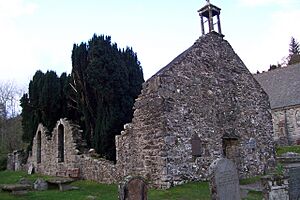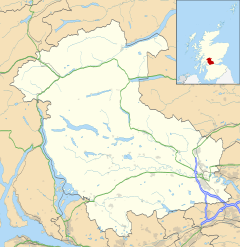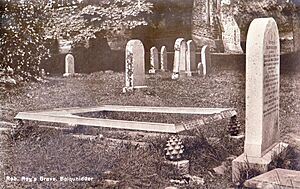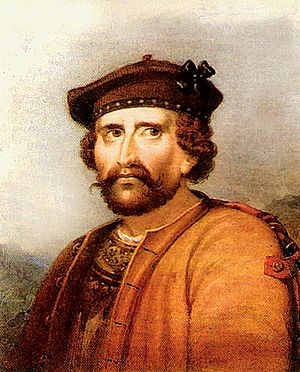Balquhidder facts for kids
Quick facts for kids Balquhidder
|
|
|---|---|
 Ruins of the former Balquhidder Church |
|
| OS grid reference | NN533208 |
| Civil parish |
|
| Council area | |
| Country | Scotland |
| Sovereign state | United Kingdom |
| Post town | Lochearnhead |
| Postcode district | FK19 |
| Dialling code | 01877 |
| Police | Central Scotland |
| Fire | Central Scotland |
| Ambulance | Scottish |
| EU Parliament | Scotland |
| UK Parliament |
|
| Scottish Parliament |
|
Balquhidder is a small village in Perthshire, Scotland. It's about 10 kilometers (6 miles) north-west of Callander. The village is part of the Stirling area. It sits below the amazing mountains of the 'Braes of Balquhidder'. This area is at the top of Loch Voil. Balquhidder Glen is a great place for fishing, watching nature, and going for walks.
Contents
Exploring Balquhidder's Past
Early Days in Balquhidder
St Angus came to Balquhidder Glen a very long time ago, in the 700s or 800s. He felt this place was special, like a "thin place" where Earth and Heaven felt close. He blessed the glen where a house called "Beannach Aonghais" (meaning 'blessing of Angus' in Gaelic) now stands. He built a small stone church at Kirkton and lived there for the rest of his life. St Angus was the first person to bring Christianity to Balquhidder.
Balquhidder is near the edge of the Scottish Highlands. This meant it became part of the land owned by the Scottish kings. From 1436, the parish became 'crown land'. This meant it belonged to the king. But the local people still had to agree to this. In 1488, the Stewart of Baldorran family was put in charge of the king's land in Balquhidder. His family stayed in charge for many years.
Powerful families like the Campbells also became important here. In 1475, King James III made Colin Campbell, the first Earl of Argyll, his main helper for keeping order in this area. The Campbell family continued to have this power. Over time, other clans like the Stewarts of Appin became allies of the Earl of Argyll.
The MacLaren and MacGregor clans also came to live in Balquhidder. The MacLarens were known as 'descendants of Laurence'. They were likely brought here by the Campbells as they expanded their lands. The first written records of both MacLarens and MacGregors in Balquhidder are from 1512. Some old Irish records suggest that the MacLaren chiefs were related to Kenneth MacAlpin. He was the king who united Scotland in the 800s. It's thought that Balquhidder lands were passed down through his family to the MacLarens.
Famous People and Events
The Reverend Robert Kirk lived in Balquhidder from 1664. He was famous for translating parts of the Gaelic Bible. He also wrote a book called The Secret Commonwealth, which was about fairies and spirits.
Rob Roy, a famous Scottish folk hero, lived and died in Balquhidder. He was sometimes called the Scottish Robin Hood. He had a long-running disagreement with the Duke of Montrose. Rob Roy was eventually pardoned by the king in 1727. He passed away in his home at Inverlochlarig Beg, Balquhidder, on December 28, 1734.
Glen Buckie, a quiet area in Balquhidder Glen, was the site of a final event from the 1745 Jacobite rising. Dr Archibald "Archie" Cameron returned to Scotland in the early 1750s. He hoped to gather support for a last effort against King George II. He was captured in the glen. Sadly, he was later hanged in London. He was the last Jacobite to be executed for trying to overthrow the king.
Balquhidder Today
The local churchyard is the final resting place of Rob Roy MacGregor. His grave has a bold message: 'MacGregor Despite Them'. He is buried with his wife and two sons. Their graves are marked by three flat stones. One stone is from their time, but the other two are older, reused medieval grave markers.
Behind the current church is a small hill called Tom nan Angeae, which means 'hill of fire'. For a long time, until the 1800s, people would light new fires here. This happened during the ancient festivals of Beltane (in spring) and Samhain (in autumn). They hoped to encourage old gods to bring warmth to the land. St Angus was buried at the bottom of this hill. A special stone was placed over him. This stone, which shows a priest holding a cup, is now inside the present church.
You can still see some parts of the old medieval church of Balquhidder. These are near Rob Roy's grave. It seems he and his family were buried right where the church's altar used to be. A few meters away are the roofless walls of the church that was built in the 1600s. The church used today was built in the 1800s. It's on a new spot north of the old graveyard. Inside, you can see the ancient stone font, which is very old. There's also a display about Balquhidder's history. The church is open to visitors in the summer. They also have evening concerts there.
The Callander and Oban Railway line reached Balquhidder in 1871. But the train line closed in 1965. The place where Balquhidder railway station used to be is now a holiday park. It has log cabins, caravans, and camping spots.
Until 1993, Balquhidder had its own primary school with just one teacher. After it closed, the children from the village started going to school in Strathyre.
The name Balquhidder is remembered in other parts of the world. For example, there's a large sheep farm called Balquhidder in South Australia. The village is also famous in a traditional Scottish song. It's called "The Braes o' Balquhidder". Robert Tannahill wrote this song. You can hear a version of it called "Wild Mountain Thyme".
You can listen to a harp version of "The Braes of Balquhidder" here: "The Braes of Balquhidder"
People Connected to Balquhidder
- David Carnegie: He helped pay for a church in Gothenburg, Sweden. It was designed to look like the church in Balquhidder, where his family had a home.
- William Stewart of Baldorran (around 1440–1500): He was the founder of the Balquhidder Stewart clan.
- Rob Roy MacGregor: An 18th-century Scottish folk hero and outlaw, sometimes called the Scottish Robin Hood. He is buried in Balquhidder Church yard.
- James Cameron: A famous movie director. His great-great-great-grandfather moved from Balquhidder, Scotland, in 1825.
Images for kids







